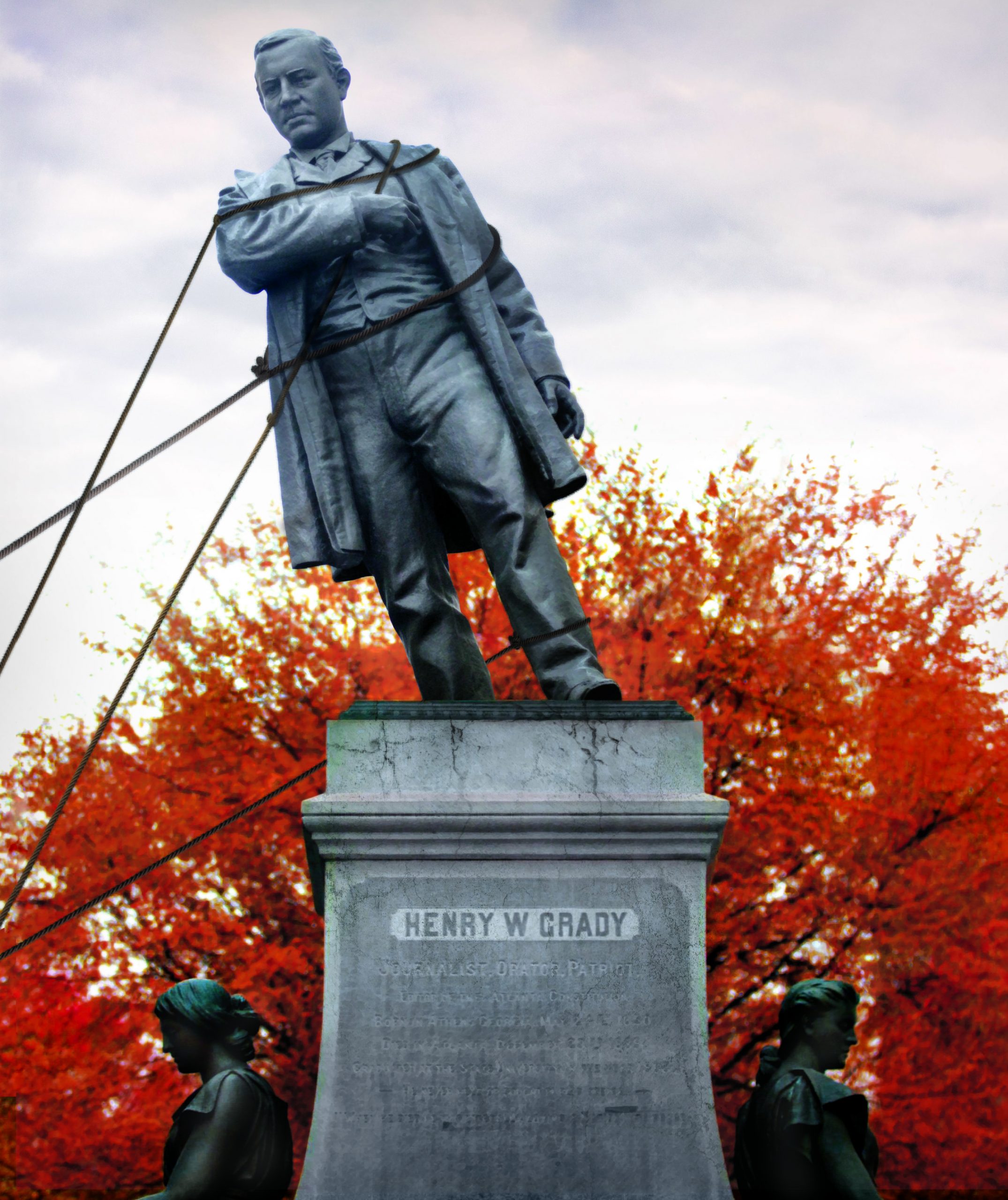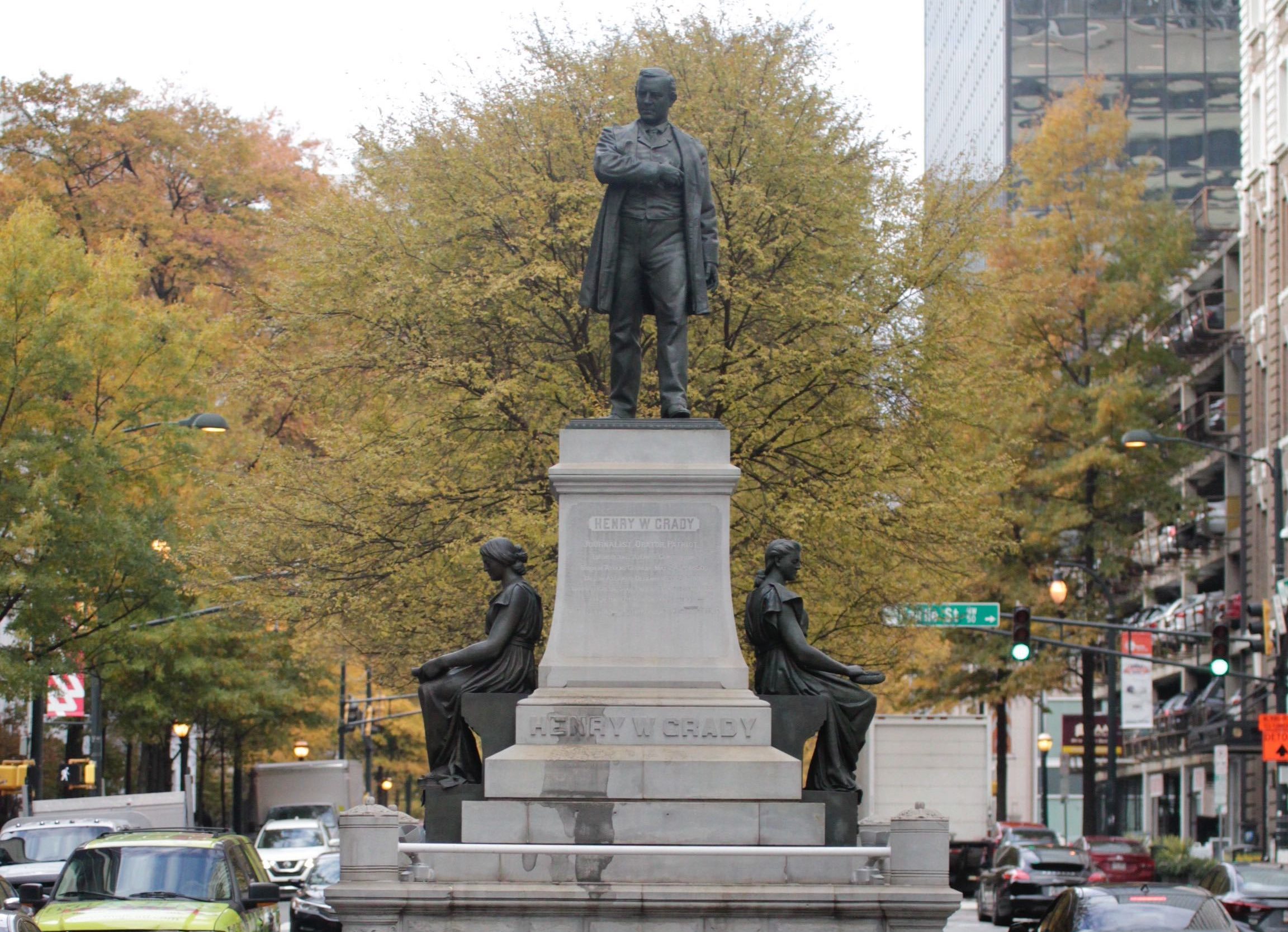That phrase, a slogan for Grady Health System’s award-winning marketing campaign that launched in 2012, is seen plastered on billboards across the metro Atlanta area. Unfortunately, it’s true in more ways than one. The Atlanta of today is the capital of black America. Our city is lauded by many as progressive, diverse and hospitable. And while this image is worth celebrating and protecting, it is undeniably distorted by a rose-tinted lens. This city, despite being over 52% black, is still the heart of the South, which is arguably the most racist region in the U.S.
Editorial: Mayor Bottoms, tear down this statue!
Written by The Signal Editorial Board • Dec. 3, 2019
Dear Mayor Bottoms,
“I wouldn’t be here without Grady.”
That phrase, a slogan for Grady Health System’s award-winning marketing campaign that launched in 2012, is seen plastered on billboards across the metro Atlanta area.
Unfortunately, it’s true in more ways than one.
The Atlanta of today is the capital of black America. Our city is lauded by many as progressive, diverse and hospitable. And while this image is worth celebrating and protecting, it is undeniably distorted by a rose-tinted lens. This city, despite being over 52% black, is still the heart of the South, which is arguably the most racist region in the U.S.
When you glance past the sea of black and brown faces, you’ll notice that Atlanta is crawling with reminders of who and what once ruled this land and its minorities unjustly. Whether it’s Stone Mountain or Lake Sidney Lanier, references to Georgia’s racist past are still visible — and often memorialized.

Editorial: Mayor Bottoms, tear down this statue!
Written by The Signal Editorial Board • Dec. 3, 2019
Dear Mayor Bottoms,
“I wouldn’t be here without Grady.”
That phrase, a slogan for Grady Health System’s award-winning marketing campaign that launched in 2012, is seen plastered on billboards across the metro Atlanta area.
Unfortunately, it’s true in more ways than one.
The Atlanta of today is the capital of black America. Our city is lauded by many as progressive, diverse and hospitable. And while this image is worth celebrating and protecting, it is undeniably distorted by a rose-tinted lens. This city, despite being over 52% black, is still the heart of the South, which is arguably the most racist region in the U.S.
When you glance past the sea of black and brown faces, you’ll notice that Atlanta is crawling with reminders of who and what once ruled this land and its minorities unjustly. Whether it’s Stone Mountain or Lake Sidney Lanier, references to Georgia’s racist past are still visible — and often memorialized.
But there is one figure who is so honored and remembered, he might as well be the poster child for Atlanta’s continued glorification of bygone racist icons: Henry W. Grady.
Grady was a central figure in the Atlanta socialscape during the late 1800s. During his time as managing editor of The Atlanta Constitution, Grady leveraged his position to advocate for a transition to his vision of a “New South,” a Southern society focused more on industry than on agriculture.
Grady’s audiences were frequently Northern cities, an indication of his goal to court investment from the North and promote the cheap labor of the South. He rejected slavery as a “feudal” system — yet, at the same time, he maintained an overt and revolting desire for the white race to reign supreme.
In 1886, he stumped for John B. Gordon, a former Confederate general and known white supremacist, for governor of Georgia. Gordon was often referred to as the “Grand Dragon” of the Ku Klux Klan in Georgia, and he “sanctioned violence [against blacks] when necessary to preserve white-dominated society.”
Gordon was elected governor later that year.
His election was a direct result of Grady’s influence. In fact, Grady has been called a “kingmaker” for playing an instrumental role in the election and appointment of white supremacist politicians, like Gordon, to the Georgia governorship and U.S. Senate. He mastered the power of his newspaper to unabashedly advance his political agenda.
Under Grady’s leadership, The Atlanta Constitution regularly published sickeningly racist headlines: “The Triple Trapeze: Three Negroes Hung to a Limb of a Tree,” “Two Minutes to Pray Before a Rope Dislocated Their Vertebrae” and “Lynching Too Good For the Black Miscreant Who Assaulted Mrs. Bush: He Will Be Lynched.”
Grady was also undoubtedly a renowned public speaker. “Oratory was a natural gift with him. It was born in him,” one publisher wrote of him in 1890.
Yet this legacy conveniently ignores one of the principal contentions in his speeches: that white men must assert their racial dominance by maintaining the economic, social and political hierarchy of the day at all costs.
“The supremacy of the white race of the South must be maintained forever and the domination of the negro race resisted at all points and at all hazards — because the white race is the superior race,” Grady said in his famous 1888 “New South” speech. “This is the declaration of no new truth. It has abided forever in the marrow of our bones and shall run forever with the blood that feeds Anglo-Saxon hearts.”
And in Grady’s final speech on “the colored problem” before his death, he reiterated that the “negro vote can never control in the South, and it will be well if partisans at the North would understand this.”
Even amid his crudely racist language, Grady often remarked that relations between black and white Americans were “cordial.”
“[That] was a brazen lie,” Kathy Roberts Forde, an associate professor of journalism at the University of Massachusetts Amherst, wrote earlier this year. “Many white Americans believed it, or pretended they did, but black editors, journalists and leaders challenged it at every turn.”
Indeed, the retrospective future was not the only audience to ridicule Grady’s values.
Ida B. Wells, civil rights champion, co-founder of the NAACP and one of the most prominent black journalists of her time, wrote in 1892 that “Henry W. Grady in his well-remembered speeches in New England and New York pictured the Afro-American as incapable of self-government.”
Wells further rejected the premise of the speech that made Grady famous, going so far as to say there was “little difference” between the New South and the Antebellum South.

A monument to Henry Grady and his accomplishments on Marietta and Forsyth streets — also named Henry Grady Square — still stands today. Etched into his plaque are three celebratory words: “Journalist, Orator, Patriot.”
Let us be clear in recognizing that Grady, as a journalist, promoted racism. Grady, as an orator, promoted racism. And Grady was certainly no patriot — he was simply a racist.
By keeping Grady on a literal and figurative pedestal, we continue to celebrate a legacy that is incompatible with Atlanta’s progressive character. Is this truly what “the city too busy to hate” celebrates?
Mayor, unless you believe Henry Grady continues to embody the values and character of our great city, we and the below signatories firmly advocate that this monument be removed from the public square and relocated to the grounds of the Atlanta History Center. But in order to relocate this monument, we first must look to the State Capitol.
The Henry Grady monument and others like it are protected by a state law passed earlier this year.
The law, Georgia Senate Bill 77, states that no monument “shall be relocated, removed, concealed, obscured, or altered in any fashion by any officer or agency.” This means that, barring “appropriate measures” for preservation or a need for relocation due to construction, no one can move this statue — at least not legally.
Furthermore, it serves the purpose of issuing penalties for two actions any person or agency — such as a city government — might take: vandalization and relocation. The second focus of the law is what makes moving Grady’s monument presently illegal.
“At a time when cities all over the country are actively removing Confederate symbols from public spaces, it is disappointing that some Georgia lawmakers are choosing to play politics with our history and promote divisiveness,” Heidi Beirich, an expert on neo-Confederate movements and white supremacism, told The Atlanta Journal-Constitution in March.
This state law is essentially operating to protect monuments to racism and the Confederacy in Georgia. We therefore have an ethical obligation to advocate not only that this law be changed, but also that our city take a clear stance against it and these monuments.
We do not advocate for the destruction of this monument, as we reject the practice of attempting to erase or conceal our past. But we do advocate for the placing of this monument within historical context and absent of civic reverence — something the Atlanta History Center can no doubt achieve.
Unfortunately, even doing this would be illegal under state law. If the monument legally qualifies for relocation, the monument must still be in a place of “similar prominence, honor, visibility, and access.”
“A monument shall not be relocated to a museum, cemetery, or mausoleum unless it was originally placed at such location,” the law states.
Mayor, you have played an invaluable role in removing what shouldn’t represent Atlanta’s character. From renaming Confederate Avenue to United Avenue, to erecting plaques adjacent to Confederate monuments that provide historical context, your work has not gone unnoticed. But, there is still more to be done.
We understand that what we hope to see in the future — the permanent relocation of the Henry Grady monument to the Atlanta History Center — is illegal under current state law. But, just because it’s the law doesn’t make it right.
What we can request today is the placement of a plaque beneath the Henry Grady monument clarifying who he was and what he believed. But more importantly, we also request that you publicly advocate for this law to be changed or unwritten. And someday, after this change, we hope to revisit our request to relocate this monument legally.
No, we wouldn’t be here without Grady. But we can’t let him define who we are and what Atlanta is today.
Signed,
The Editorial Board of The Signal
The Young Democrats of Georgia
Georgia State University Student Government Association Office of the President
Georgia State University Student Government Association Office of the Atlanta Executive Vice President
The Black Student Alliance at Georgia State University
